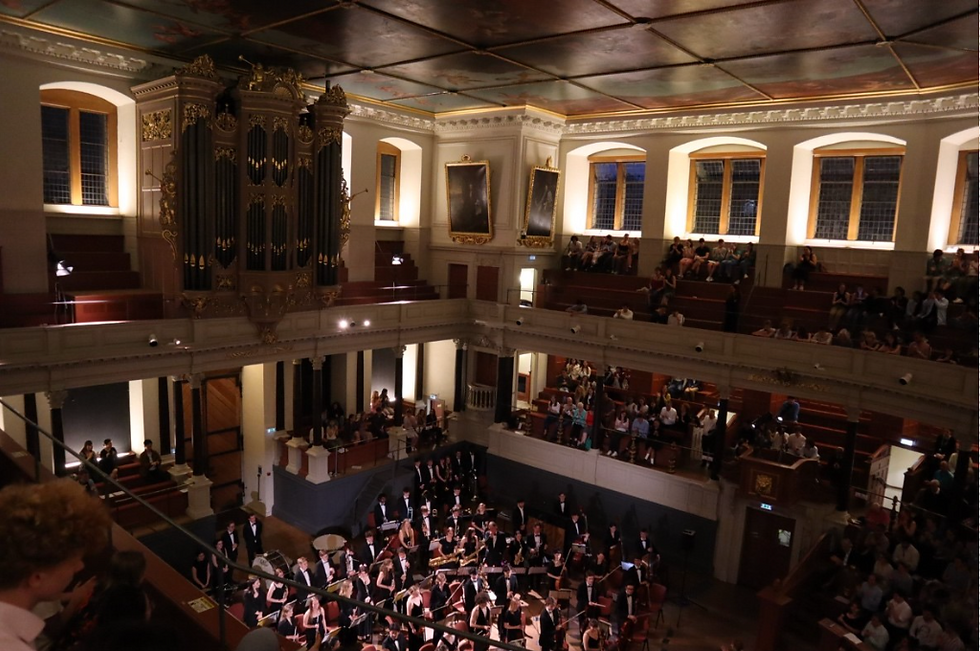REVIEW: OUPhil – HT19
- Evie Brenkley

- Mar 8, 2019
- 3 min read
by Annie Zykova

The Oxford University Philharmonia delivered a stunning performance of Dvořák’s Violin Concerto and Ranchmaninoff’s ‘Symphony No.2’ at the Sheldonian Theatre on Wednesday 27th February. The impressive turnout to the concert, conducted by Joseph Beesley and led by Louis Morford, showed just how well-reputed the ensemble is in Oxford. As one of the most prestigious venues in the city, the Sheldonian Theatre in all its architectural sophistication could not have been a better choice of venue to complement the formidable standard of the music. The subtle lighting also ensured a successful balance between grandeur and intimacy.
Opening with Dvořák’s colourful and dynamic Violin Concerto, the technical skill of the violin soloist, Elizabeth Nurse, was formidable. Full of rigorously demanding sections, Nurse maintained a solid command of the part throughout, attaining excellent technical precision without compromising on the subtlety of the dynamics. This concerto was striking in its regular vacillation in texture, tempo, and mood, thus acting as a perfect way for the ensemble to display their full capacity for versatility – a challenge which they impressively overcame. Even when the texture was at its thinnest and most exposing, these regular and dramatic changes did not throw the performers off guard. If there was any aspect deserving even of the slightest criticism, the single element that could be pointed out is that there were occasional moments when rhythmic precision of the brass section could have been even more refined. However, given that this occurred on a dramatically small number of occasions within a concerto that lasted over half an hour, this aspect was extremely minor and did not take away from the richness of the sound as a whole.
A musical icon for Czech patriotism, given Dvořák’s great interest in the incorporation of folk melodies from his native Bohemia into his own compositions, the historical and cultural importance of this work was certainly done justice. Interestingly, the original violinist for whom the masterpiece was written in 1878, Joseph Joachim, did not receive it favourably. A musician with a very strict belief about what constitutes a worthy composition, Joachim was skeptical about Dvořák’s unconventional abrupt truncation of the orchestral tutti in the first movement. The violinist’s main disapproval of the concerto was its occasional lack of gradual transitions in favour of more dramatic changes between sections. This illustrates one of Dvořák’s most distinct features as a composer; his inspirations lying in deep-rooted folk traditions of his native land, yet adapting these in an approach that was cutting-edge for his time, unafraid to deviate away from the conventions adhered to by many of his contemporaries.
Rachmaninoff’s ‘Symphony No.2’, which was played in the second half of the concert, complemented Dvořák’s composition whilst also providing an interesting contrast. Just as rich in its variety, with sections ranging from those requiring an acute tenderness to those demanding an expression of utmost intensity, this piece similarly showcased the ensemble’s remarkable ability to deliver a convincing interpretation of drastically contrasting motifs. This was best exemplified in the fourth movement, which opens with a playful first section, almost reminiscent of a fanfare, and which progresses to a more rigid woodwind interlude. One could especially appreciate the space that this symphony offered each section of the orchestra to showcase their individual sounds, an exposure which led to a refreshing, intimate feel as it contrasted to the impassioned, mighty sections when the entire philharmonia came together. The dark undertones characteristic of Rachmaninoff were conveyed so persuasively that the ensemble’s sensitivity to the individual features of both composers could not be ignored.
The fusion of the music and the beauty of the venue made this performance an unmissable event in Oxford’s musical calendar. The ensemble made a very praiseworthy selection of compositions to perform, which struck the balance between complementing one another through being united by their demanding, storytelling quality, but also being some of the best works by the composers that bring out their characteristic features. A wonderful experience.







Comments